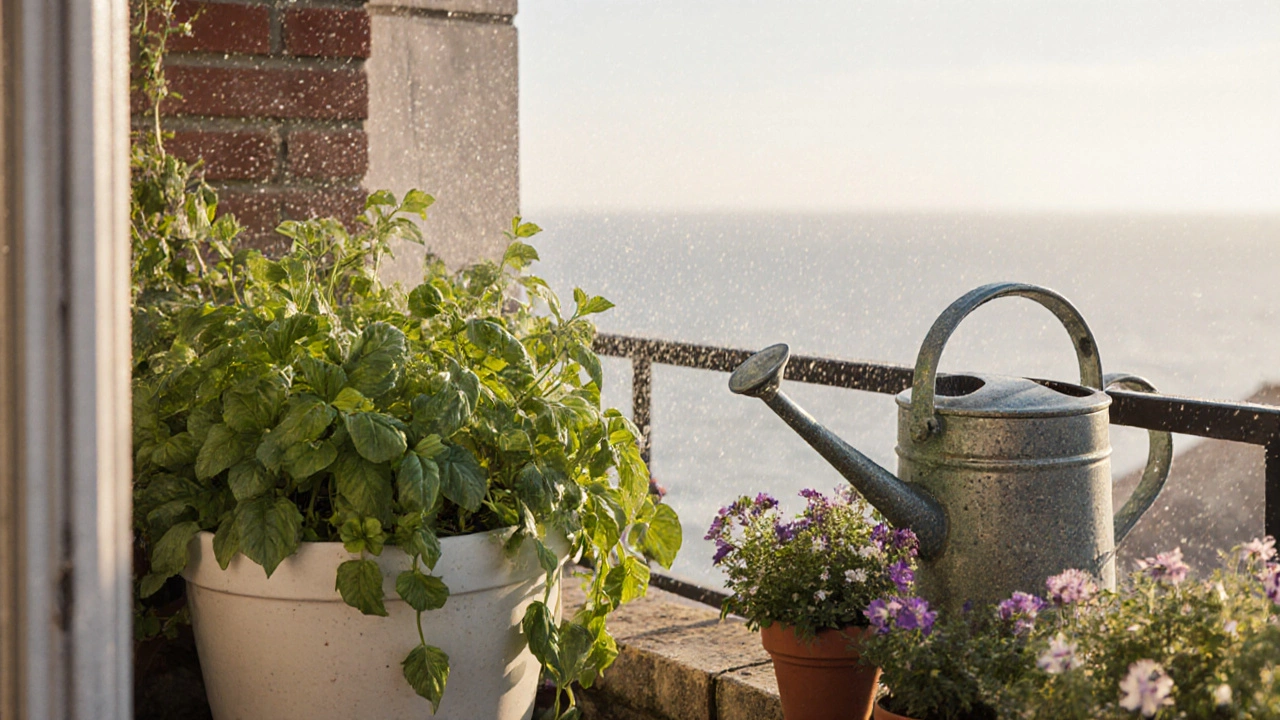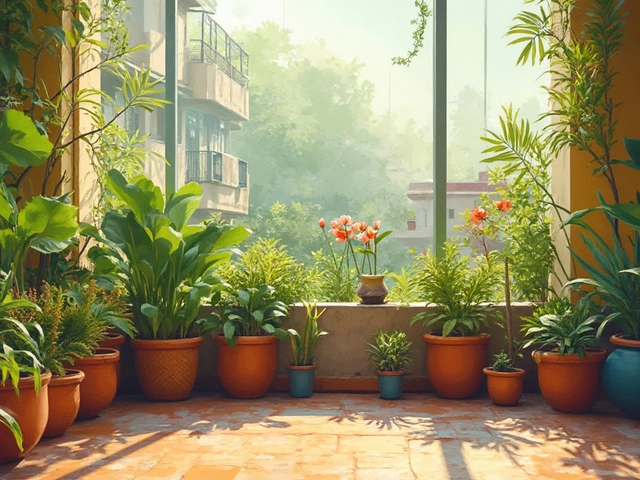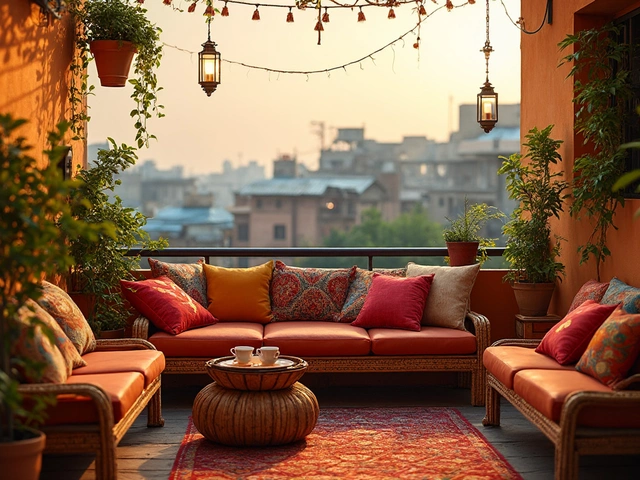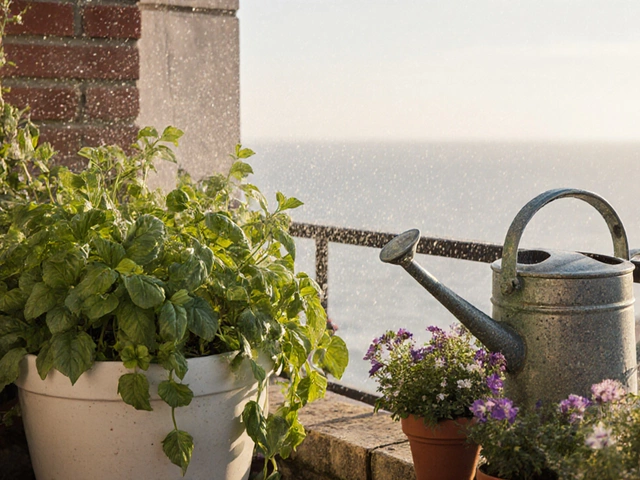Balcony Plant Container Calculator
Choose your plant
Recommended Container Size
Minimum Pot Diameter:
---
Soil Volume:
---
Keeping a balcony garden alive isn’t just about planting pots and hoping for the best. It’s about understanding how wind, sun, and space work together-especially in a place like Brighton, where sea breezes can dry out soil in hours and winter rains turn small balconies into muddy traps. If your plants keep dying, it’s not you. It’s probably the setup.
Start with the right containers
Not all pots are made equal. Plastic pots are light and cheap, but they crack in frost. Terracotta looks nice, but it dries out fast and gets heavy when wet. For most balconies, go for lightweight fiberglass or glazed ceramic. They hold moisture better, don’t get too hot in summer, and won’t tip over when the wind picks up.Size matters too. A 12-inch pot is fine for herbs or lettuce. But if you want tomatoes, peppers, or cucumbers, you need at least 15 gallons of soil per plant. A 5-gallon bucket with drainage holes works fine if you’re on a budget. Just make sure every container has holes. No exceptions. Standing water kills roots faster than neglect.
Use quality potting mix-not garden soil
Garden soil from your yard? Don’t use it. It compacts in pots, blocks drainage, and brings pests or weeds you didn’t ask for. Instead, buy a good quality potting mix labeled for containers. Look for one with peat moss or coir, perlite, and compost. These ingredients hold water without turning to mud.In Brighton, the air is salty and damp. That means your soil can get salty over time from sea spray. Every 6 months, flush your pots with clean water. Let it drain completely. This washes out built-up salts that stop roots from absorbing nutrients.
Water smart-don’t just water often
Most balcony gardeners overwater. They see dry soil and think, “I need to pour more.” But surface dryness doesn’t mean the roots are thirsty. Stick your finger 2 inches down. If it’s damp, wait. If it’s dry, water slowly until it runs out the bottom.On hot, windy days, you might need to water twice. In winter, you might go a week without. Use a watering can with a long spout. It lets you target the soil, not the leaves. Wet leaves in cool, damp climates like ours invite fungal diseases. Mildew on your basil? That’s usually from misting instead of watering the roots.
Install a drip irrigation kit if you travel often. A simple timer-connected system with micro-tubing costs under £30 and can keep things alive for two weeks. No more come-home-to-dead-plants syndrome.
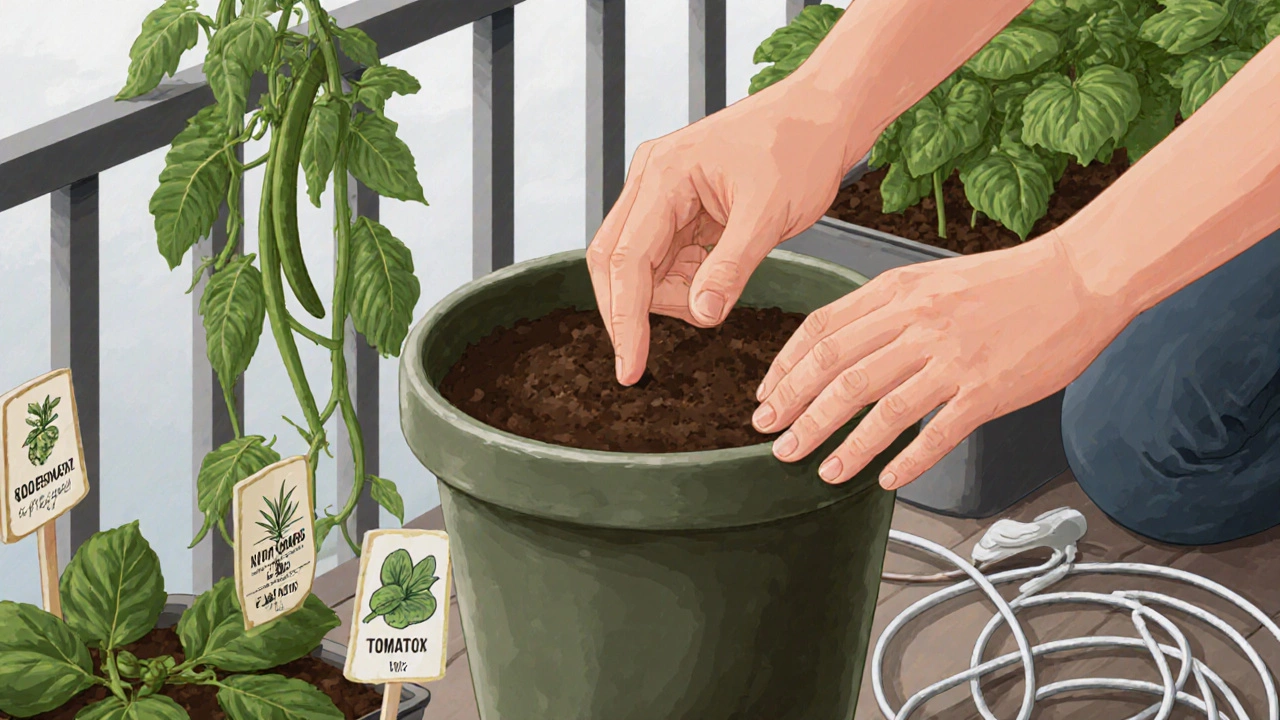
Choose plants that actually belong on a balcony
Not every plant thrives in a container on a fifth-floor balcony. Pick based on light, wind, and space.- Full sun (6+ hours): Tomatoes, peppers, rosemary, lavender, marigolds
- Partial sun (3-6 hours): Lettuce, spinach, chives, strawberries, begonias
- Shade (under 3 hours): Ferns, hostas, mint, parsley, salad greens
Wind is your silent killer. Tall plants like sunflowers or corn? Avoid them unless you have a windbreak. Use trellises for climbers like beans or cucumbers-they grow up, not out. And always anchor heavy pots. A 20-pound pot falling off a balcony isn’t just a mess. It’s dangerous.
Fertilize less, but more often
Plants in pots run out of food faster than those in the ground. But over-fertilizing burns roots. Use a balanced liquid fertilizer (like 10-10-10) every 2-3 weeks during spring and summer. Cut back in fall. Stop in winter unless you’re growing something like winter lettuce.Organic options like seaweed extract or worm castings work well. They release nutrients slowly and won’t shock the plant. Avoid slow-release granules-they often don’t break down properly in containers and can leach into the soil unevenly.
Watch for pests and diseases early
Balcony gardens are small, so pests spread fast. Aphids, spider mites, and whiteflies love tender new growth. Check under leaves every few days. A quick spray of water can knock off most bugs. For stubborn cases, use insecticidal soap or neem oil. Spray in the evening-sun on wet leaves can burn them.Yellow leaves? Could be overwatering, nutrient lack, or root rot. Brown leaf tips? Usually salt buildup or dry air. Don’t guess. Look at the whole plant. A single symptom rarely tells the whole story.

Seasonal care: What to do each month
March-April: Start sowing cool-season crops-lettuce, radishes, peas. Repot anything that’s root-bound. Clean out old debris from last season.
May-June: Plant tomatoes, peppers, basil. Begin regular feeding. Install shade cloth if your balcony gets blazing afternoon sun.
July-August: Water daily if it’s hot. Pinch off dead flowers to keep plants blooming. Harvest herbs often-they grow bushier when trimmed.
September-October: Sow winter greens like kale and spinach. Move tender plants indoors if frost is near. Clean pots for next year.
November-February: Minimal watering. Protect pots from freezing by wrapping them in bubble wrap. Don’t fertilize. Let plants rest.
Common mistakes and how to fix them
- Mistake: Too many plants in one pot. Fix: Give each plant room. Crowding = poor air flow = mold and pests.
- Mistake: Using the same soil for years. Fix: Replace half the soil every spring. Add fresh compost.
- Mistake: Ignoring drainage. Fix: Always use pots with holes. Raise pots on bricks to let water escape.
- Mistake: Planting everything at once. Fix: Stagger planting. Sow lettuce every 2 weeks for continuous harvest.
Your balcony isn’t just a space. It’s a micro-ecosystem. Treat it like one. Pay attention. Adjust. Watch how your plants respond. The best balcony gardeners aren’t the ones with the fanciest pots. They’re the ones who notice when a leaf curls, when the soil feels lighter, when the wind changes direction.
How often should I water my balcony garden?
There’s no fixed schedule. Check the soil with your finger-water only when the top 2 inches are dry. In hot, windy weather, you might need to water daily. In winter, once every 7-10 days may be enough. Always let water drain out the bottom.
Can I grow vegetables on a north-facing balcony?
Yes, but your options are limited. North-facing balconies get little direct sun. Stick to shade-tolerant crops: leafy greens like spinach, kale, and lettuce; herbs like parsley, mint, and chives; and root vegetables like radishes. Avoid tomatoes, peppers, or cucumbers-they need at least 6 hours of sun.
What’s the best soil for balcony plants?
Use a high-quality potting mix designed for containers. It should contain peat moss or coir, perlite for drainage, and compost for nutrients. Avoid garden soil-it compacts and suffocates roots. In coastal areas like Brighton, choose a mix with added lime to counteract salt buildup from sea spray.
Why are my plant leaves turning yellow?
Yellow leaves can mean several things: overwatering (most common), lack of nitrogen, or salt buildup from hard water or sea spray. Check the soil moisture first. If it’s wet, hold off on watering. If it’s dry and yellowing, try a diluted liquid fertilizer. If leaves have brown edges, flush the soil with clean water to remove salts.
How do I protect my plants from wind on a high balcony?
Use trellises, screens, or tall plants like bamboo or ornamental grasses as windbreaks. Anchor heavy pots with brackets or non-slip pads. Avoid tall, top-heavy plants like sunflowers. Choose low, sturdy varieties-dwarf tomatoes, compact herbs, and trailing plants like lobelia handle wind better.
Should I bring my plants indoors in winter?
Only if they’re frost-tender. Herbs like basil, tomatoes, and citrus trees need indoor warmth. Hardy plants like kale, rosemary, and thyme can survive outdoors with protection-wrap pots in bubble wrap and place them against a wall. Never bring plants inside too early. They need a cold period to rest.
Next steps: Start small, stay consistent
You don’t need a full balcony garden to succeed. Start with three pots: one with basil, one with lettuce, and one with a trailing plant like ivy or lobelia. Water them. Watch them. Learn their rhythm. In a month, you’ll know more than most people who’ve been gardening for years.The goal isn’t perfection. It’s presence. A few thriving plants on your balcony mean you’re connected to the seasons, even in the middle of the city. That’s worth more than a perfect harvest.
